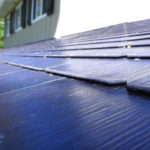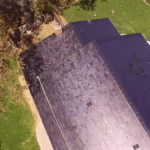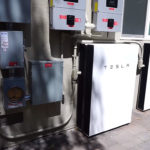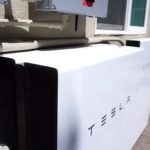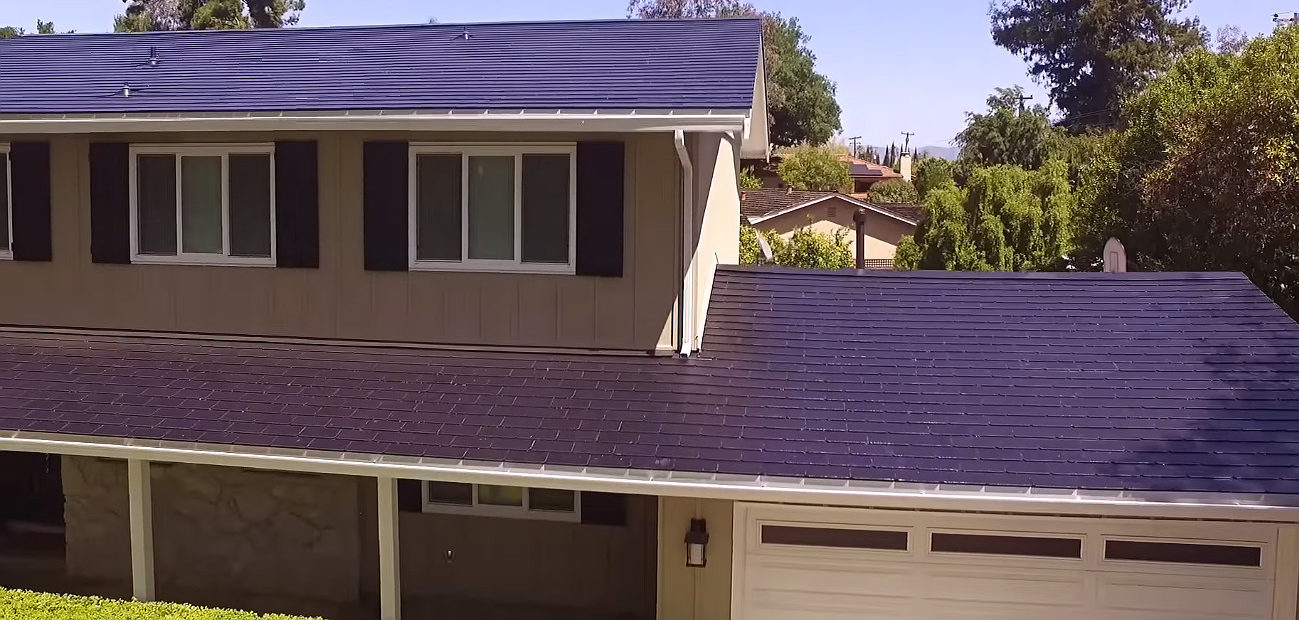
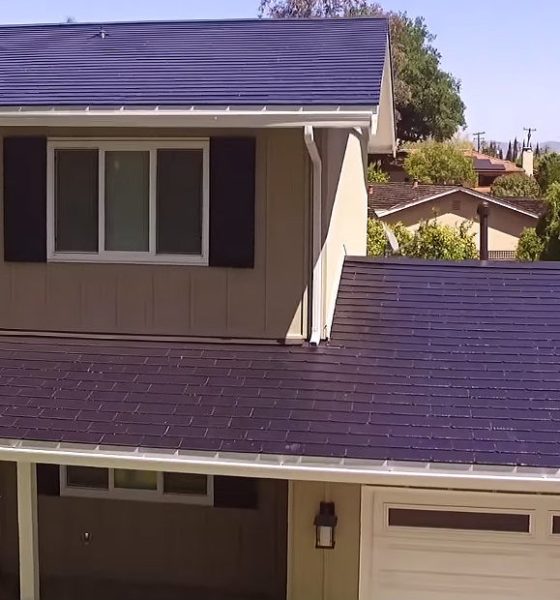
Energy
Tesla Solar Roof owner discusses installation price, maintenance, and savings
One of Tesla’s first residential Solar Roof customers has provided more details about his recently-installed solar and battery system. In a follow-up interview with E for Electric‘s Alex Guberman, Tri Huynh, the owner of the Solar Roof-equipped home, discussed the costs associated with the installation, how much power his solar shingles gather on average, the system’s maintenance, and savings that he has seen so far.
Huynh noted that the entire Solar Roof installation for his 1,000-square-foot roof totaled $100,000, which included the cost of all the tiles and three Powerwall 2 home batteries. The Solar Roof owner added that Tesla’s shingles became a reasonable investment for him since he was in the market for a new roof anyway, and his home is in Northern CA, where sunshine is abundant. Huynh was given a quote of $50,000 for the complete replacement of his roof alone. The Solar Roof owner stated that when he priced out a new roof and traditional solar panels, it came to around $70,000 without any batteries.
Tesla finished the installation of the Solar Roof system earlier this year, but Huynh was only able to connect it to the grid after three months due to backlogs with his area’s utility company. The system has only been powered on for half a billing cycle, and according to the Solar Roof owner, his estimated electric bill so far is around $90 from its usual $350 monthly rate. Huynh noted that the system charges two electric cars — a Chevy Bolt EV and a Tesla Model 3 — as well as air conditioning, and a dryer.
- A Tesla Solar Roof installation. [Credit: E for Electric/YouTube]
- A Tesla Solar Roof installation. [Credit: E for Electric/YouTube]
- A Tesla Solar Roof installation. [Credit: E for Electric/YouTube]
- A Tesla Solar Roof installation. [Credit: E for Electric/YouTube]
Tesla’s Solar Roof and Powerwall 2 batteries installed on Tri Huynh’s Northern CA home. [Credit: E for Electric/YouTube]
Power produced by the Solar Roof tiles has been quite substantial, with the system producing up to 10 kW of power, which is enough to fully charge his Powerwall 2 batteries in several hours. Huynh noted that on an average CA day, his Solar Roof tiles produce around 7-8 kW. The lowest his system has produced to date was 3 kW, which happened during an overcast day. Overall, Huynh stated that with the system running, the Solar Roof tiles are enough to keep his home’s lights on 80% of the time without relying on the grid.
The Solar Roof tiles are practically maintenance-free. Huynh stated that when he signed the contract for the solar system, Tesla provided him with performance measurements that the Solar Roof tiles should display. Tesla monitors the roof’s performance and degradation over time, and in the event that the system falls below its listed performance measurement, Tesla would come to the site to fix and optimize the solar shingles at no additional cost.
Overall, Huynh noted that he is fully satisfied with his Solar Roof purchase.
“I’m amazed at how much power the sun generates. It’s amazing. I feel like every house should have solar. I know it’s expensive, but I think we should all work towards that,” he said.
Earlier this month, CTO JB Straubel stated that Tesla is “aggressively ramping” its efforts to address the demand for the company’s residential battery and solar products. Straubel further noted that Tesla is expecting to pick up production of the Powerwall 2 home battery later this year. Production of the Solar Roof tiles is expected to accelerate in 2019. With these initiatives, the Tesla CTO expects to see reduced wait times for the company’s residential products.
When Tesla CEO Elon Musk unveiled the Solar Roof tiles, he noted that the shingles could turn out to be a “Keeping up with the Joneses” situation. The shingles, which are specifically designed to mimic the appearance of regular roof tiles, are expected to further the company’s mission of accelerating the market towards sustainable solutions.
“You want to call your neighbors over and say, ‘Check out the sweet roof.’ It’s like, not a phrase that you hear often, but that’s the key to it. People really care about their homes; they love their homes, and they want them to be better,” Musk said.
Watch E for Electric‘s follow-up interview with the Solar Roof customer in the video below.

Energy
Tesla starts hiring efforts for Texas Megafactory
Tesla’s Brookshire site is expected to produce 10,000 Megapacks annually, equal to 40 gigawatt hours of energy storage.

Tesla has officially begun hiring for its new $200 million Megafactory in Brookshire, Texas, a manufacturing hub expected to employ 1,500 people by 2028. The facility, which will build Tesla’s grid-scale Megapack batteries, is part of the company’s growing energy storage footprint.
Tesla’s hiring efforts for the Texas Megafactory are hinted at by the job openings currently active on the company’s Careers website.
Tesla’s Texas Megafactory
Tesla’s Brookshire site is expected to produce 10,000 Megapacks annually, equal to 40 gigawatt hours of energy storage, similar to the Lathrop Megafactory in California. Tesla’s Careers website currently lists over 30 job openings for the site, from engineers, welders, and project managers. Each of the openings is listed for Brookshire, Texas.
The company has leased two buildings in Empire West Business Park, with over $194 million in combined property and equipment investment. Tesla’s agreement with Waller County includes a 60% property tax abatement, contingent on meeting employment benchmarks: 375 jobs by 2026, 750 by 2027, and 1,500 by 2028, as noted in a report from the Houston Business Journal. Tesla is required to employ at least 1,500 workers in the facility through the rest of the 10-year abatement period.
Tesla’s clean energy boom
City officials have stated that Tesla’s arrival marks a turning point for the Texas city, as it highlights a shift from logistics to advanced clean energy manufacturing. Ramiro Bautista from Brookshire’s economic development office, highlighted this in a comment to the Journal.
“(Tesla) has great-paying jobs. Not just that, but the advanced manufacturing (and) clean energy is coming to the area,” he said. “So it’s not just your normal logistics manufacturing. This is advanced manufacturing coming to this area, and this brings a different type of job and investment into the local economy.”
Energy
Tesla and Samsung SDI in talks over new US battery storage deal: report
The update was related by industry sources and initially reported by South Korean news outlets.

Recent reports have suggested that Tesla and Samsung SDI are in talks over a potential partnership to supply batteries for large-scale energy storage systems (ESS).
The update was related by industry sources and initially reported by South Korean news outlets.
ESS batteries to be built at Samsung’s Indiana plant
As noted in a report from Korea JoongAng Daily, the demand for energy storage systems has been growing rapidly in North America, thanks in no small part to the surge in AI investments across numerous companies. With this in mind, Tesla has reportedly approached Samsung SDI about a potential battery supply deal.
The deal is reportedly worth over 3 trillion Korean won (approximately $2.11 billion) and will span three years, according to The Korea Global Economic Daily. A battery supply deal with Samsung SDI could make sense for Tesla as the company already has a grid-scale battery, the Megapack, which is perfect for industrial use. Samsung SDI could simply supply cells for the EV maker.
Production of the batteries would reportedly take place at Samsung SDI’s joint venture factory with Stellantis in Indiana, which is currently under construction. Samsung SDI recently announced plans to use part of that plant’s EV lines to produce cells for ESS, with a targeted capacity of 30 GWh by the end of next year.
Tesla and Samsung’s partnership
At present, only a handful of manufacturers, including Korea’s LG Energy Solution, Samsung SDI, SK On, and Japan’s Panasonic, are capable of producing energy storage-scale batteries domestically in the United States. A Samsung SDI official issued a comment about the matter, stating, “Nothing has been finalized regarding cooperation with Tesla.”
The possible energy storage system deal adds another layer to Tesla’s growing collaboration with Samsung, which is already in line as a partner in the upcoming production of Tesla’s AI5 and AI6 chips. Early sample manufacturing of the AI6 is expected to begin in South Korea, with mass production slated for Samsung’s Texas-based Taylor foundry when it starts operations.
The AI6 chip will power Tesla’s next wave of high-volume projects, including the Optimus humanoid robot and the autonomous Cybercab service. Musk has called the partnership with Samsung a “real collaboration,” adding that he personally plans to “walk the line” at the Taylor facility to speed up progress.
Energy
Tesla VP hints at Solar Roof comeback with Giga New York push
The comments hint at possible renewed life for the Solar Roof program, which has seen years of slow growth since its 2016 unveiling.

Tesla’s long-awaited and way underrated Solar Roof may finally be getting its moment. During the company’s Q3 2025 earnings call, Vice President of Energy Engineering Michael Snyder revealed that production of a new residential solar panel has started at Tesla’s Buffalo, New York facility, with shipments to customers beginning in the first quarter of 2026.
The comments hint at possible renewed life for the Solar Roof program, which has seen years of slow growth since its 2016 unveiling.
Tesla Energy’s strong demand
Responding to an investor question about Tesla’s energy backlog, Snyder said demand for Megapack and Powerwall continues to be “really strong” into next year. He also noted positive customer feedback for the company’s new Megablock product, which is expected to start shipping from Houston in 2026.
“We’re seeing remarkable growth in the demand for AI and data center applications as hyperscalers and utilities have seen the versatility of the Megapack product. It increases reliability and relieves grid constraints,” he said.
Snyder also highlighted a “surge in residential solar demand in the US,” attributing the spike to recent policy changes that incentivize home installations. Tesla expects this trend to continue into 2026, helped by the rollout of a new solar lease product that makes adoption more affordable for homeowners.
Possible Solar Roof revival?
Perhaps the most intriguing part of Snyder’s remarks, however, was Tesla’s move to begin production of its “residential solar panel” in Buffalo, New York. He described the new panels as having “industry-leading aesthetics” and shape performance, language Tesla has used to market its Solar Roof tiles in the past.
“We also began production of our Tesla residential solar panel in our Buffalo factory, and we will be shipping that to customers starting Q1. The panel has industry-leading aesthetics and shape performance and demonstrates our continued commitment to US manufacturing,” Snyder said during the Q3 2025 earnings call.
Snyder did not explicitly name the product, though his reference to aesthetics has fueled speculation that Tesla may finally be preparing a large-scale and serious rollout of its Solar Roof line.
Originally unveiled in 2016, the Solar Roof was intended to transform rooftops into clean energy generators without compromising on design. However, despite early enthusiasm, production and installation volumes have remained limited for years. In 2023, a report from Wood Mackenzie claimed that there were only 3,000 operational Solar Roof installations across the United States at the time, far below forecasts. In response, the official Tesla Energy account on X stated that the report was “incorrect by a large margin.”
